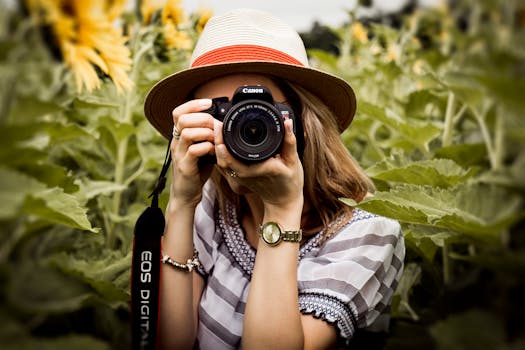Shoot in RAW Format
Photography enthusiasts often grapple with the decision of whether to shoot in RAW format or stick with JPEG. The choice can significantly impact the quality and flexibility of your images. RAW files capture unprocessed data from your camera's sensor, offering a wealth of benefits over JPEGs, which compress and process the image data in-camera. Understanding these advantages can elevate your photography game, whether you're a seasoned professional or just starting out.

RAW format preserves all the intricate details that your camera sensor captures, allowing for greater latitude in post-processing. This means you can correct exposure errors, recover highlights and shadows, and fine-tune colors without degrading the image quality. On the other hand, JPEG files discard a lot of this information to save space, limiting your editing options. Thus, shooting in RAW is like having a digital negative that you can manipulate extensively to achieve your desired outcome.
Moreover, RAW files are invaluable for achieving professional results. They provide a broader color gamut and higher bit depth, essential for producing prints that are true to life. This is particularly crucial for photographers whose work appears in high-end publications such as National Geographic or Vogue. By shooting in RAW, you ensure that every pixel of your image is at its best, ready for any level of post-production excellence.
Enhanced Image Quality
The primary advantage of shooting in RAW format is the superior image quality it offers. Unlike JPEGs, which are compressed and processed by the camera, RAW files retain all the data captured by the sensor. This results in images with more detail and a higher dynamic range.
For instance, when you shoot a landscape at sunrise or sunset, the wide range of light intensities can be challenging to capture accurately. With RAW files, you can adjust the exposure and recover both highlights and shadows without introducing noise or artifacts. This capability ensures that your final image looks closer to what you saw with your own eyes.
Additionally, RAW files contain more color information than JPEGs. While JPEGs are limited to 8-bit color depth (256 levels per channel), RAW files often support 12-bit or even 14-bit depth (4,096 to 16,384 levels per channel). This translates to smoother gradients and more accurate color reproduction in your photos.
Greater Flexibility in Post-Processing
Shooting in RAW gives you unparalleled control during post-processing. Software like Adobe Lightroom and Photoshop can read the unprocessed data from RAW files, allowing you to make adjustments that would be impossible with JPEGs.
For example, if an image is slightly underexposed, you can increase the exposure in post-processing without significantly degrading the image quality. Similarly, white balance adjustments are more effective with RAW files because they contain all the original color information.
Moreover, RAW files allow for non-destructive editing. You can make changes to the file without altering the original data. This means you can always go back to the unedited version if needed. In contrast, every edit you make to a JPEG file degrades its quality over time.
Professional Standards
If you're aiming for professional-quality photos, shooting in RAW is essential. Many high-end publications and clients expect photographers to deliver images with the highest possible quality. RAW files meet this requirement by providing maximum detail and flexibility.
For instance, National Geographic requires photographers to submit images in RAW format for their assignments. This standard ensures that editors have the flexibility to make necessary adjustments without compromising image quality.
Furthermore, many professional photo labs prefer RAW files for printing because they offer more data to work with. This results in prints with better color accuracy and detail compared to those made from JPEG files.
Storage Considerations
One downside of shooting in RAW format is the larger file size compared to JPEGs. A single RAW file can be two to six times larger than a JPEG file of the same scene. This means you'll need more storage space for your photos.
However, storage solutions have become increasingly affordable and accessible. High-capacity memory cards and external hard drives are now available at reasonable prices. Additionally, cloud storage services offer convenient options for backing up your RAW files.
| File Type | Average File Size | Color Depth | Editing Flexibility |
|---|---|---|---|
| RAW | 20-50 MB | 12-14 bit | High |
| JPEG | 5-10 MB | 8 bit | Low |
Shooting Efficiency
Shooting in RAW might slow down your workflow initially due to larger file sizes and additional steps in post-processing. However, many photographers find that the benefits far outweigh these drawbacks.
Cameras today are equipped with faster processors and larger buffers that can handle continuous shooting in RAW mode without significant lag. Additionally, advancements in software have made post-processing more efficient than ever before.
The Verdict: Is Shooting in RAW Worth It?
Shooting in RAW format is undeniably beneficial for anyone serious about photography. The enhanced image quality, greater flexibility in post-processing, and adherence to professional standards make it a preferred choice among professionals and enthusiasts alike.
The investment in storage solutions and time spent on post-processing is well worth it when you consider the superior results you can achieve. By mastering the use of RAW files, you unlock new creative possibilities and ensure that your photos stand out in any context.
If you're still on the fence about making the switch from JPEG to RAW, consider trying both formats simultaneously using your camera's dual-format recording option. This way, you can compare the differences firsthand and appreciate the benefits of shooting in RAW format.